Citroen BERLINGO RHD 2017 2.G Owner's Manual
Manufacturer: CITROEN, Model Year: 2017, Model line: BERLINGO RHD, Model: Citroen BERLINGO RHD 2017 2.GPages: 260, PDF Size: 8.59 MB
Page 131 of 260
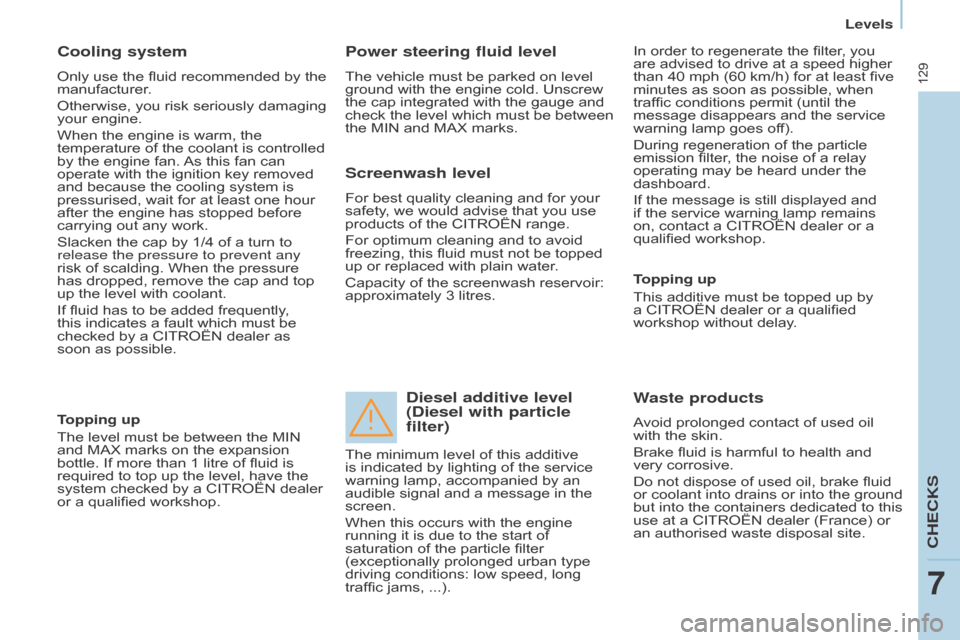
129
Berlingo2VU_en_Chap07_Verification_ed02-2016Berlingo2VU_en_Chap07_Verification_ed02-2016
Cooling system
Only use the fluid recommended by the
manufacturer.
Otherwise, you risk seriously damaging
your engine.
When the engine is warm, the
temperature of the coolant is controlled
by the engine fan. As this fan can
operate with the ignition key removed
and because the cooling system is
pressurised, wait for at least one hour
after the engine has stopped before
carrying out any work.
Slacken the cap by 1/4 of a turn to
release the pressure to prevent any
risk of scalding. When the pressure
has dropped, remove the cap and top
up the level with coolant.
If fluid has to be added frequently,
this indicates a fault which must be
checked by a CITROËN dealer as
soon as possible.
Power steering fluid level
The vehicle must be parked on level
ground with the engine cold. Unscrew
the cap integrated with the gauge and
check the level which must be between
the MIN and MAX marks.In order to regenerate the filter, you
are advised to drive at a speed higher
than 40 mph (60 km/h) for at least five
minutes as soon as possible, when
traffic conditions permit (until the
message disappears and the service
warning lamp goes off).
During regeneration of the particle
emission filter, the noise of a relay
operating may be heard under the
dashboard.
If the message is still displayed and
if the service warning lamp remains
on, contact a CITROËN dealer or a
qualified workshop.
Topping up
The level must be between the MIN
and MAX marks on the expansion
bottle. If more than 1 litre of fluid is
required to top up the level, have the
system checked by a CITROËN dealer
or a qualified workshop.
Screenwash level
For best quality cleaning and for your
safety, we would advise that you use
products of the CITROËN range.
For optimum cleaning and to avoid
freezing, this fluid must not be topped
up or replaced with plain water.
Capacity of the screenwash reservoir:
approximately 3 litres.
Diesel additive level
(Diesel with particle
filter)
Topping up
This additive must be topped up by
a CITROËN dealer or a qualified
workshop without delay.
Waste products
Avoid prolonged contact of used oil
with the skin.
Brake fluid is harmful to health and
very corrosive.
Do not dispose of used oil, brake fluid
or coolant into drains or into the ground
but into the containers dedicated to this
use at a CITROËN dealer (France) or
an authorised waste disposal site.
The minimum level of this additive
is indicated by lighting of the service
warning lamp, accompanied by an
audible signal and a message in the
screen.
When this occurs with the engine
running it is due to the start of
saturation of the particle filter
(exceptionally prolonged urban type
driving conditions: low speed, long
traffic jams, ...).
CHECKS
7
Levels
Page 132 of 260
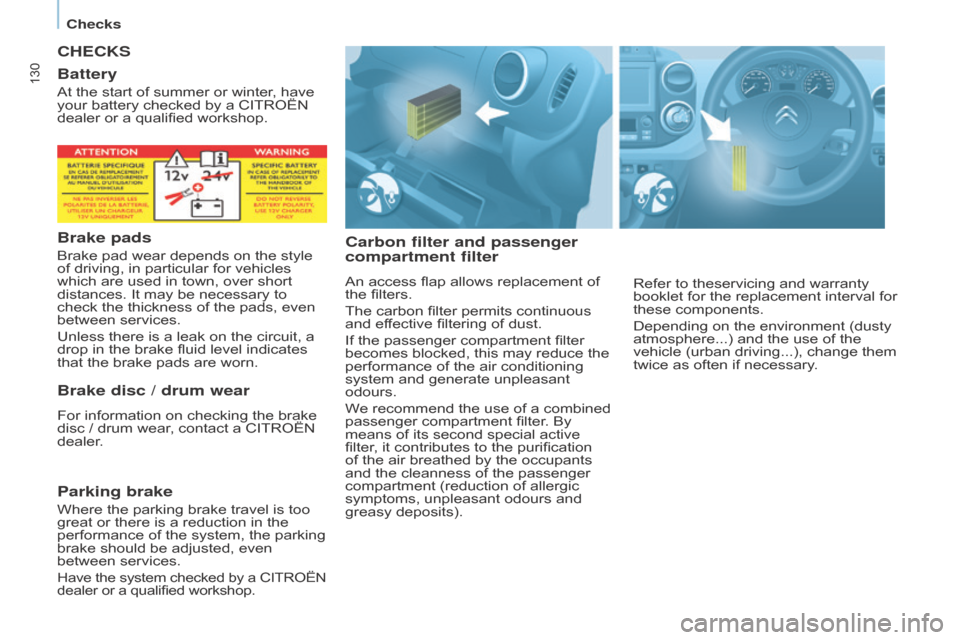
130
Berlingo2VU_en_Chap07_Verification_ed02-2016Berlingo2VU_en_Chap07_Verification_ed02-2016
CHECKS
Carbon filter and passenger
compartment filter
An access flap allows replacement of
the filters.
The carbon filter permits continuous
and effective filtering of dust.
If the passenger compartment filter
becomes blocked, this may reduce the
performance of the air conditioning
system and generate unpleasant
odours.
We recommend the use of a combined
passenger compartment filter. By
means of its second special active
filter, it contributes to the purification
of the air breathed by the occupants
and the cleanness of the passenger
compartment (reduction of allergic
symptoms, unpleasant odours and
greasy deposits).
Battery
At the start of summer or winter, have
your battery checked by a CITROËN
dealer or a qualified workshop.
Brake pads
Brake pad wear depends on the style
of driving, in particular for vehicles
which are used in town, over short
distances. It may be necessary to
check the thickness of the pads, even
between services.
Unless there is a leak on the circuit, a
drop in the brake fluid level indicates
that the brake pads are worn.
Brake disc / drum wear
For information on checking the brake
disc / drum wear, contact a CITROËN
dealer.
Parking brake
Where the parking brake travel is too
great or there is a reduction in the
performance of the system, the parking
brake should be adjusted, even
between services.
Have the system checked by a CITROËN
dealer or a qualified workshop.
Refer to theservicing and warranty
booklet for the replacement interval for
these components.
Depending on the environment (dusty
atmosphere...) and the use of the
vehicle (urban driving...), change them
twice as often if necessary.
Checks
Page 133 of 260
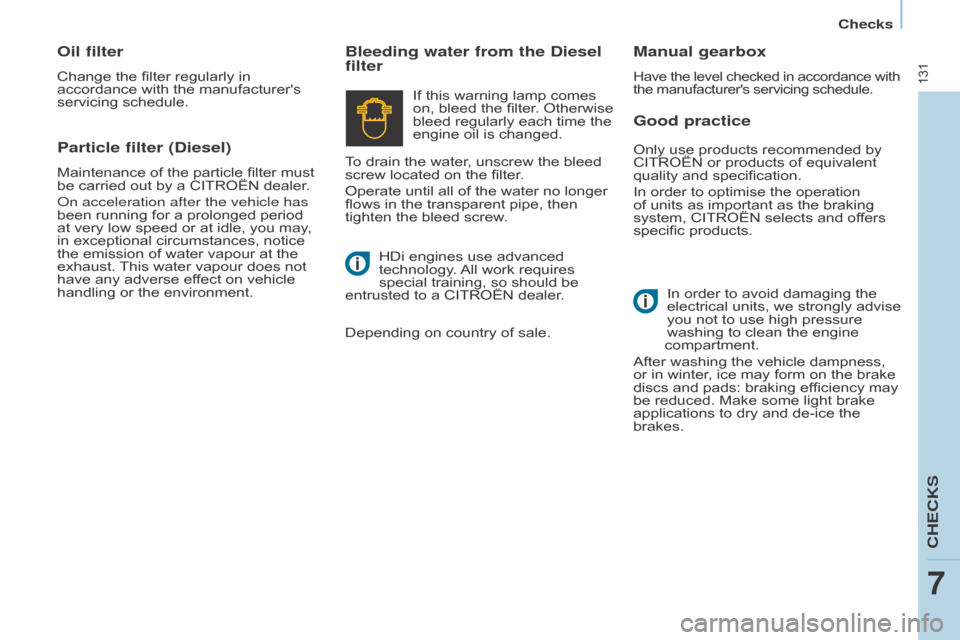
131
Berlingo2VU_en_Chap07_Verification_ed02-2016Berlingo2VU_en_Chap07_Verification_ed02-2016
Good practice
Bleeding water from the Diesel
filter
Manual gearbox
Have the level checked in accordance with
the manufacturer's servicing schedule.
In order to avoid damaging the
electrical units, we strongly advise
you not to use high pressure
washing to clean the engine
compartment.
After washing the vehicle dampness,
or in winter, ice may form on the brake
discs and pads: braking efficiency may
be reduced. Make some light brake
applications to dry and de-ice the
brakes.
If this warning lamp comes
on, bleed the filter. Otherwise
bleed regularly each time the
engine oil is changed.
To drain the water, unscrew the bleed
screw located on the filter.
Operate until all of the water no longer
flows in the transparent pipe, then
tighten the bleed screw.
Particle filter (Diesel)
Maintenance of the particle filter must
be carried out by a CITROËN dealer.
On acceleration after the vehicle has
been running for a prolonged period
at very low speed or at idle, you may,
in exceptional circumstances, notice
the emission of water vapour at the
exhaust. This water vapour does not
have any adverse effect on vehicle
handling or the environment.
Oil filter
Change the filter regularly in
accordance with the manufacturer's
servicing schedule.
HDi engines use advanced
technology. All work requires
special training, so should be
entrusted to a CITROËN dealer.
Depending on country of sale. Only use products recommended by
CITROËN or products of equivalent
quality and specification.
In order to optimise the operation
of units as important as the braking
system, CITROËN selects and offers
specific products.
CHECKS
7
Checks
Page 134 of 260
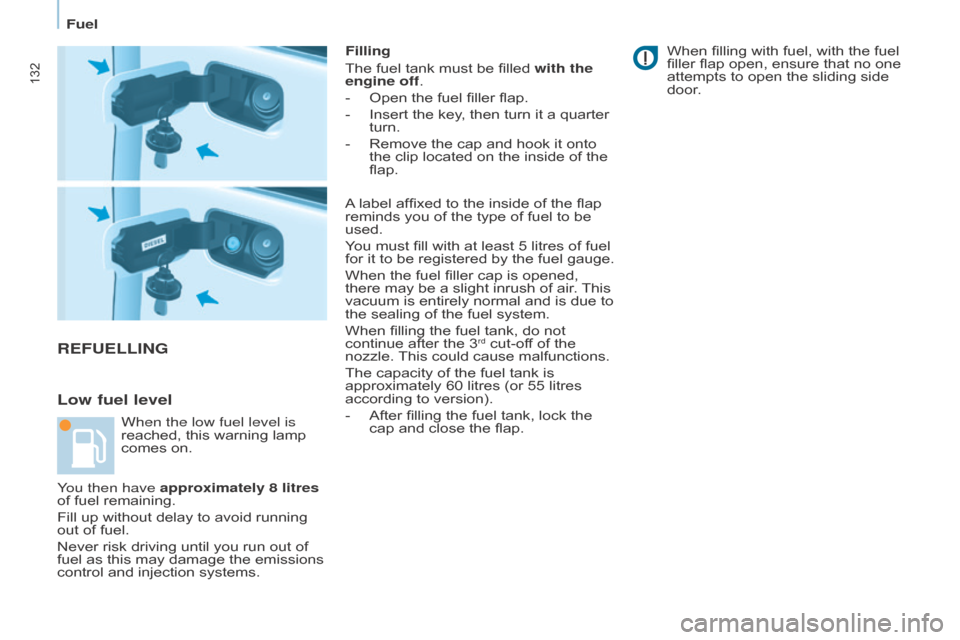
132
Berlingo2VU_en_Chap07_Verification_ed02-2016Berlingo2VU_en_Chap07_Verification_ed02-2016
REFUELLING
Low fuel level
Filling
The fuel tank must be filled with the
engine off.
-
Open the fuel filler flap.
-
Insert the key
, then turn it a quarter
turn.
-
Remove the cap and hook it onto
the clip located on the inside of the
flap. When fillin
g with fuel, with the fuel
filler flap open, ensure that no one
attempts to open the sliding side
door.
When the low fuel level is
reached, this warning lamp
comes on.
You then have approximately 8 litres
of fuel remaining.
Fill up without delay to avoid running
out of fuel.
Never risk driving until you run out of
fuel as this may damage the emissions
control and injection systems. A label affixed to the inside of the flap
reminds you of the type of fuel to be
used.
You must fill with at least 5 litres of fuel
for it to be registered by the fuel gauge.
When the fuel filler cap is opened,
there may be a slight inrush of air. This
vacuum is entirely normal and is due to
the sealing of the fuel system.
When filling the fuel tank, do not
continue after the 3
rd cut-off of the
nozzle. This could cause malfunctions.
The capacity of the fuel tank is
approximately 60 litres (or 55 litres
according to version).
-
After fillin
g the fuel tank, lock the
cap and close the flap.
Fuel
Page 135 of 260
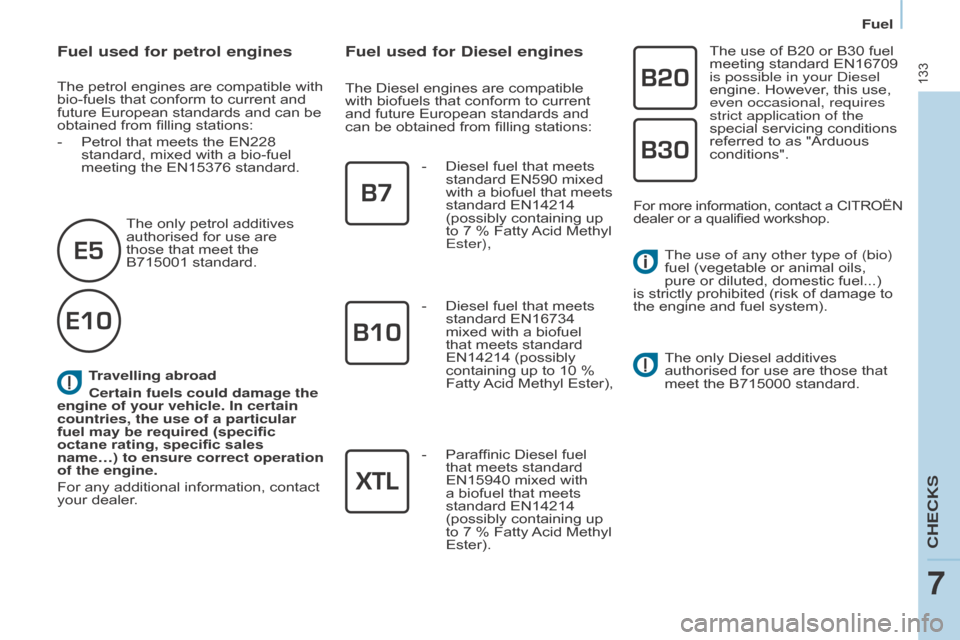
133
Berlingo2VU_en_Chap07_Verification_ed02-2016Berlingo2VU_en_Chap07_Verification_ed02-2016
Travelling abroad
Certain fuels could damage the
engine of your vehicle. In certain
countries, the use of a particular
fuel may be required (specific
octane rating, specific sales
name…) to ensure correct operation
of the engine.
For any additional information, contact
your dealer.
Fuel used for petrol engines
The petrol engines are compatible with
bio-fuels that conform to current and
future European standards and can be
obtained from filling stations:
-
Petrol that meets the EN228
standard, mixed with a bio-fuel
meeting the EN15376 standard.
The only petrol additives
authorised for use are
those that meet the
B715001
standard.
Fuel used for Diesel engines
The Diesel engines are compatible
with biofuels that conform to current
and future European standards and
can be obtained from filling stations:-
Diesel fuel that meets
standard EN590 mixed
with a biofuel that meets
standard EN14214
(possibly containing up
to 7 % Fatty
Acid Methyl
Ester), The use of B20 or B30 fuel
meeting standard EN16709
is possible in your Diesel
engine. However, this use,
even occasional, requires
strict application of the
special servicing conditions
referred to as "Arduous
conditions".
-
Diesel fuel that meets
standard EN16734
mixed with a biofuel
that meets standard
EN14214 (possibly
containing up to 10 %
Fatty
Acid Methyl Ester),
For more information, contact a CITROËN
dealer or a qualified workshop.
- Paraffinic Diesel fuel
that meets standard
EN15940 mixed with
a biofuel that meets
standard EN14214
(possibly containing up
to 7 % Fatty Acid Methyl
Ester). The use of any other type of (bio)
fuel (vegetable or animal oils,
pure or diluted, domestic fuel...)
is strictly prohibited (risk of damage to
the engine and fuel system).
The only Diesel additives
authorised for use are those that
meet the B715000 standard.
CHECKS
7
Fuel
Page 136 of 260
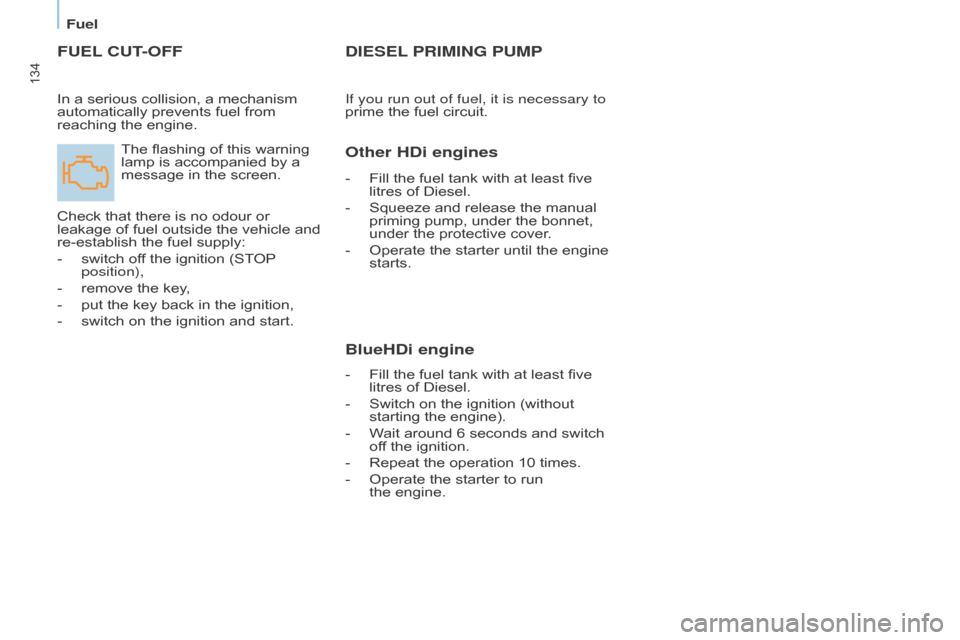
134
Berlingo2VU_en_Chap07_Verification_ed02-2016Berlingo2VU_en_Chap07_Verification_ed02-2016
FUEL CUT- OFF
The flashing of this warning
lamp is accompanied by a
message in the screen.
Check that there is no odour or
leakage of fuel outside the vehicle and
re-establish the fuel supply:
-
switch of
f the ignition (STOP
position),
-
remove the key
,
-
put the key back in the ignition,
-
switch on the ignition and start.
DIESEL PRIMING PUMP
In a serious collision, a mechanism
automatically prevents fuel from
reaching the engine. If you run out of fuel, it is necessary to
prime the fuel circuit.
Other HDi engines
- Fill the fuel tank with at least five
litres of Diesel.
-
Squeeze and release the manual
priming pump, under the bonnet,
under the protective cover
.
-
Operate the starter until the engine
starts.
BlueHDi engine
- Fill the fuel tank with at least five
litres of Diesel.
-
Switch on the ignition (without
starting the engine).
-
W
ait around 6 seconds and switch
off the ignition.
-
Repeat the operation 10 times.
-
Operate the starter to run
the
engine.
Fuel
Page 137 of 260
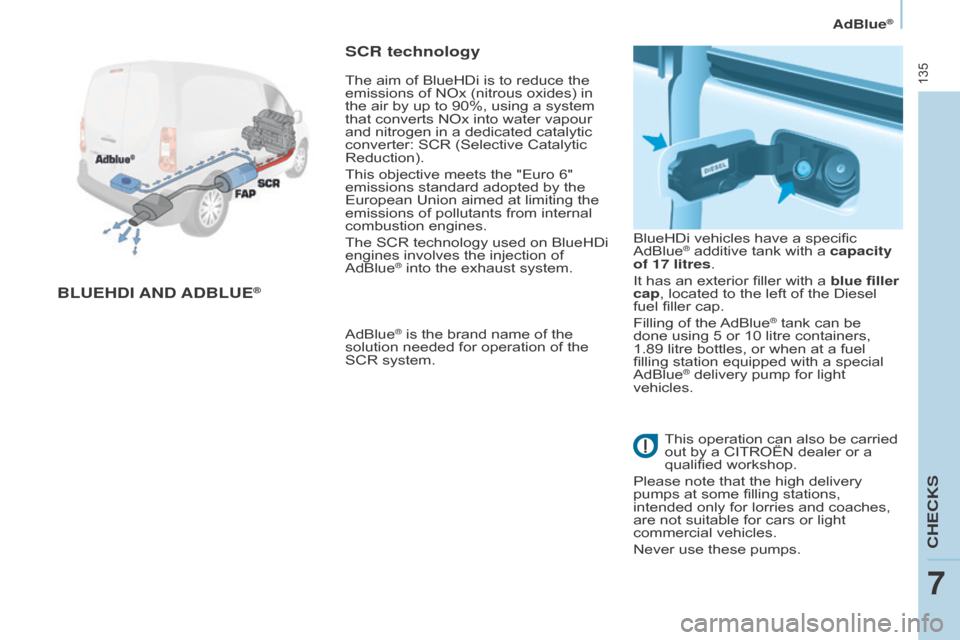
135
Berlingo2VU_en_Chap07_Verification_ed02-2016Berlingo2VU_en_Chap07_Verification_ed02-2016
BLUEHDI AND ADBLUE®
SCR technology
AdBlue® is the brand name of the
solution needed for operation of the
SCR system. BlueHDi vehicles have a specific
AdBlue
® additive tank with a capacity
of 17 litres.
It has an exterior filler with a blue filler
cap, located to the left of the Diesel
fuel filler cap.
Filling of the AdBlue
® tank can be
done using 5 or 10 litre containers,
1.89 litre bottles, or when at a fuel
filling station equipped with a special
AdBlue
® delivery pump for light
vehicles.
The aim of BlueHDi is to reduce the
emissions of NOx (nitrous oxides) in
the air by up to 90%, using a system
that converts NOx into water vapour
and nitrogen in a dedicated catalytic
converter: SCR (Selective Catalytic
Reduction).
This objective meets the "Euro 6"
emissions standard adopted by the
European Union aimed at limiting the
emissions of pollutants from internal
combustion engines.
The SCR technology used on BlueHDi
engines involves the injection of
AdBlue
® into the exhaust system.
This operation can also be carried
out by a CITROËN dealer or a
qualified workshop.
Please note that the high delivery
pumps at some filling stations,
intended only for lorries and coaches,
are not suitable for cars or light
commercial vehicles.
Never use these pumps.
CHECKS
7
AdBlue®
Page 138 of 260
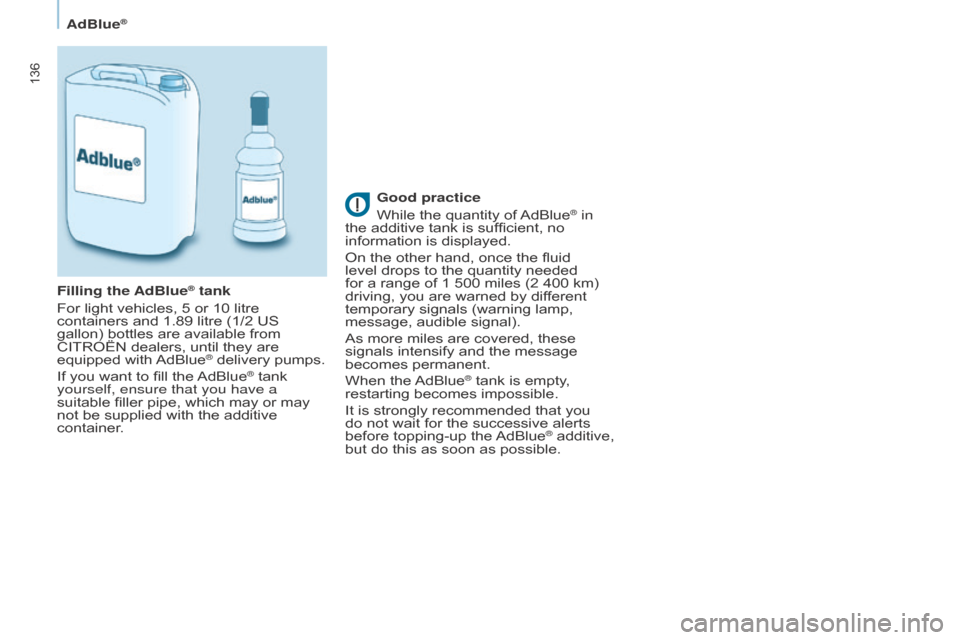
136
Berlingo2VU_en_Chap07_Verification_ed02-2016Berlingo2VU_en_Chap07_Verification_ed02-2016
Good practice
While the quantity of AdBlue® in
the additive tank is sufficient, no
information is displayed.
On the other hand, once the fluid
level drops to the quantity needed
for a range of 1 500 miles (2 400 km)
driving, you are warned by dif
ferent
temporary signals (warning lamp,
message, audible signal).
As more miles are covered, these
signals intensify and the message
becomes permanent.
When the AdBlue
® tank is empty,
restarting becomes impossible.
It is strongly recommended that you
do not wait for the successive alerts
before topping-up the AdBlue
® additive,
but do this as soon as possible.
Filling the AdBlue
® tank
For light vehicles, 5 or 10 litre
containers and 1.89 litre (1/2 US
gallon) bottles are available from
CITROËN dealers, until they are
equipped with AdBlue
® delivery pumps.
If you want to fill the AdBlue® tank
yourself, ensure that you have a
suitable filler pipe, which may or may
not be supplied with the additive
container.
AdBlue®
Page 139 of 260
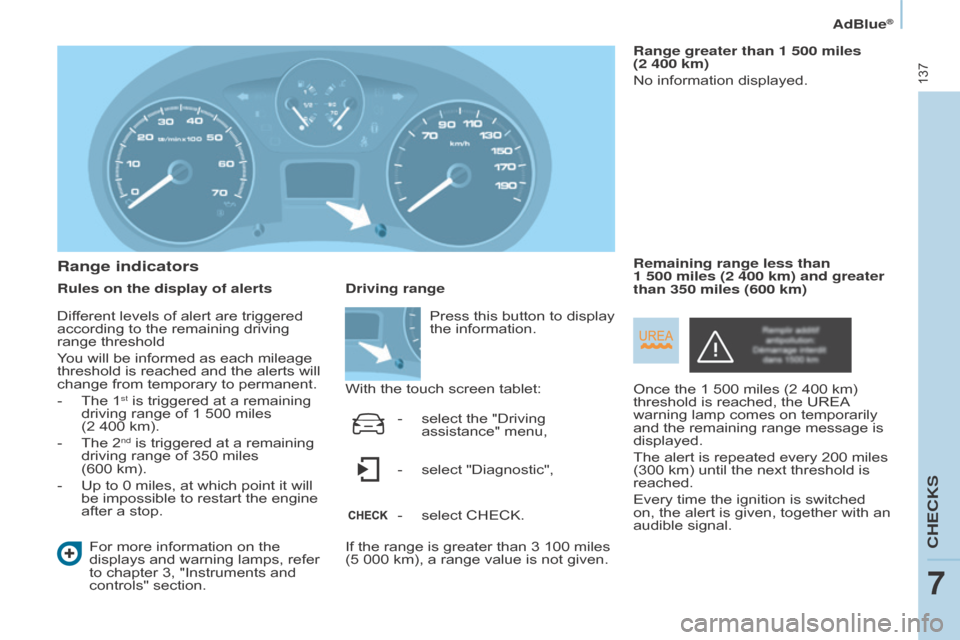
137
Berlingo2VU_en_Chap07_Verification_ed02-2016Berlingo2VU_en_Chap07_Verification_ed02-2016
Range indicators
Rules on the display of alertsFor more information on the
displays and warning lamps, refer
to chapter 3, "Instruments and
controls" section. Range greater than 1 500 miles
(2 400 km)
No information displayed.
Once the 1 500 miles (2 400 km)
threshold is reached, the UREA
warning lamp comes on temporarily
and the remaining range message is
displayed.
The alert is repeated every 200 miles
(300 km) until the next threshold is
reached.
Every time the ignition is switched
on, the alert is given, together with an
audible signal. Remaining range less than
1 500 miles (2 400 km) and greater
than 350 miles (600 km)
Driving range
With the touch screen tablet:
If the range is greater than 3 100 miles
(5 000 km), a range value is not given. Press this button to display
the information.
-
select the "Driving
assistance" menu,
-
select "Diagnostic",
-
select CHECK.
Dif
ferent levels of alert are triggered
according to the remaining driving
range threshold
You will be informed as each mileage
threshold is reached and the alerts will
change from temporary to permanent.
-
The 1st is triggered at a remaining
driving range of 1 500 miles
(2 400 km).
-
The 2nd is triggered at a remaining
driving range of 350 miles
(600
km).
-
Up to 0 miles, at which point it will
be impossible to restart the engine
after a stop.
CHECKS
7
AdBlue®
Page 140 of 260
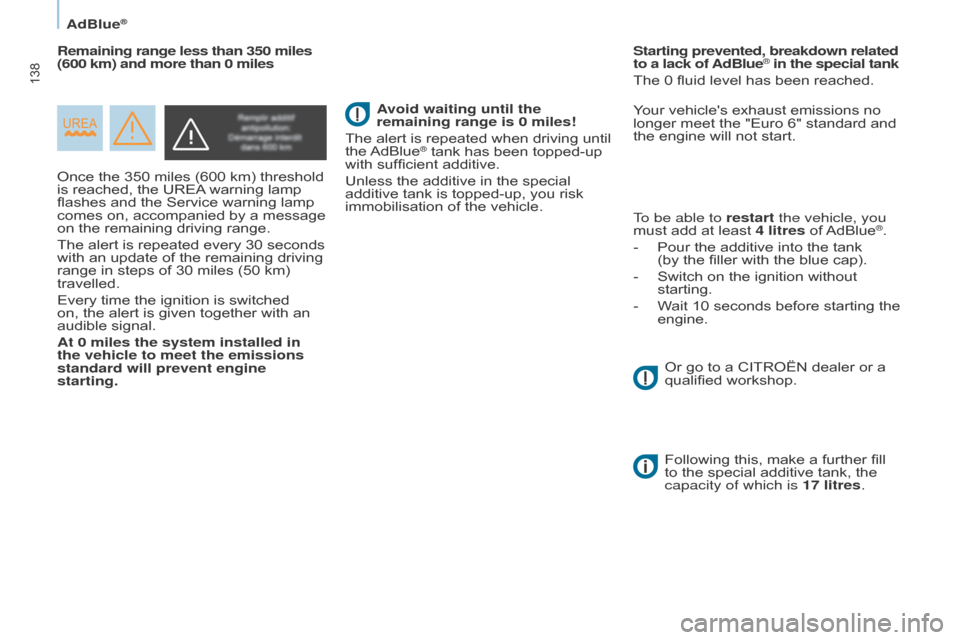
138
Berlingo2VU_en_Chap07_Verification_ed02-2016Berlingo2VU_en_Chap07_Verification_ed02-2016
Once the 350 miles (600 km) threshold
is reached, the UREA warning lamp
flashes and the Service warning lamp
comes on, accompanied by a message
on the remaining driving range.
The alert is repeated every 30 seconds
with an update of the remaining driving
range in steps of 30 miles (50 km)
travelled.
Every time the ignition is switched
on, the alert is given together with an
audible signal.
At 0 miles the system installed in
the vehicle to meet the emissions
standard will prevent engine
starting.Your vehicle's exhaust emissions no
longer meet the "Euro 6" standard and
the engine will not start.
To be able to restart the vehicle, you
must add at least 4 litres of AdBlue
®.
-
Pour the additive into the tank
(by the filler with the blue cap).
-
Switch on the ignition without
starting.
-
W
ait 10 seconds before starting the
engine.
Remaining range less than 350 miles
(600 km) and more than 0 miles
Starting prevented, breakdown related
to a lack of AdBlue
®
in the special tank
The 0 fluid level has been reached.
Avoid waiting until the
remaining range is 0 miles!
The alert is repeated when driving until
the AdBlue
® tank has been topped-up
with sufficient additive.
Unless the additive in the special
additive tank is topped-up, you risk
immobilisation of the vehicle.
Following this, make a further fill
to the special additive tank, the
capacity of which is 17 litres. Or go to a CITROËN dealer or a
qualified workshop.
AdBlue®